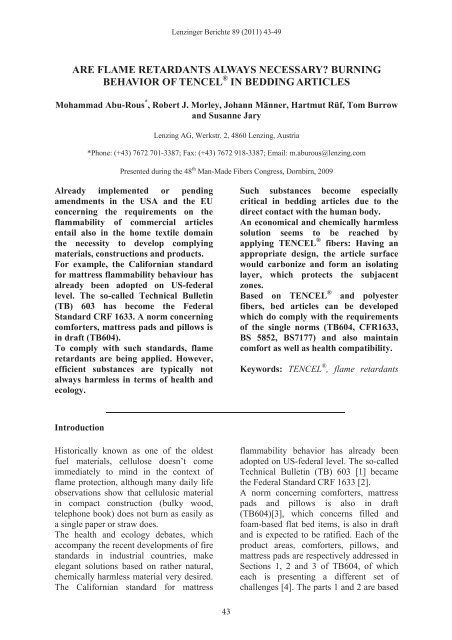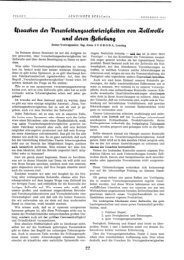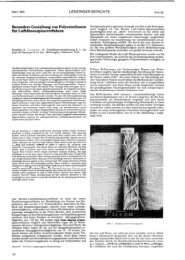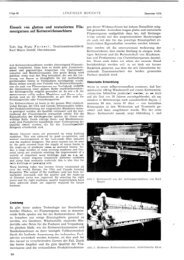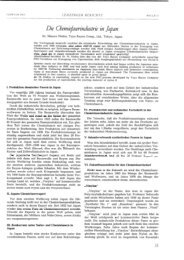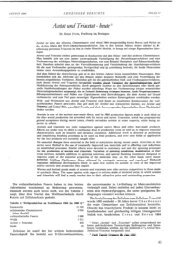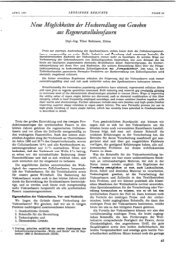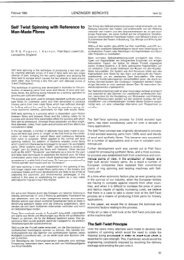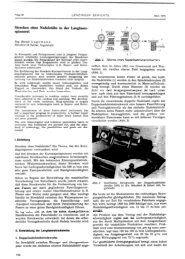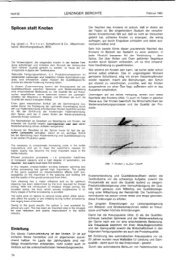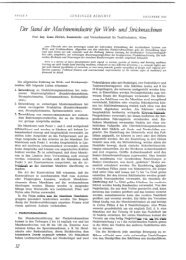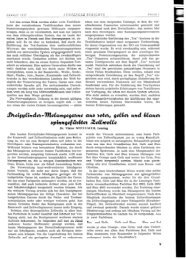burning behavior - Lenzing
burning behavior - Lenzing
burning behavior - Lenzing
You also want an ePaper? Increase the reach of your titles
YUMPU automatically turns print PDFs into web optimized ePapers that Google loves.
<strong>Lenzing</strong>er Berichte 89 (2011) 43-49<br />
ARE FLAME RETARDANTS ALWAYS NECESSARY? BURNING<br />
BEHAVIOR OF TENCEL ® IN BEDDING ARTICLES<br />
Mohammad Abu-Rous * , Robert J. Morley, Johann Männer, Hartmut Rüf, Tom Burrow<br />
and Susanne Jary<br />
<strong>Lenzing</strong> AG, Werkstr. 2, 4860 <strong>Lenzing</strong>, Austria<br />
*Phone: (+43) 7672 701-3387; Fax: (+43) 7672 918-3387; Email: m.aburous@lenzing.com<br />
Presented during the 48 th Man-Made Fibers Congress, Dornbirn, 2009<br />
Already implemented or pending<br />
amendments in the USA and the EU<br />
concerning the requirements on the<br />
flammability of commercial articles<br />
entail also in the home textile domain<br />
the necessity to develop complying<br />
materials, constructions and products.<br />
For example, the Californian standard<br />
for mattress flammability behaviour has<br />
already been adopted on US-federal<br />
level. The so-called Technical Bulletin<br />
(TB) 603 has become the Federal<br />
Standard CRF 1633. A norm concerning<br />
comforters, mattress pads and pillows is<br />
in draft (TB604).<br />
To comply with such standards, flame<br />
retardants are being applied. However,<br />
efficient substances are typically not<br />
always harmless in terms of health and<br />
ecology.<br />
Such substances become especially<br />
critical in bedding articles due to the<br />
direct contact with the human body.<br />
An economical and chemically harmless<br />
solution seems to be reached by<br />
applying TENCEL ® fibers: Having an<br />
appropriate design, the article surface<br />
would carbonize and form an isolating<br />
layer, which protects the subjacent<br />
zones.<br />
Based on TENCEL ® and polyester<br />
fibers, bed articles can be developed<br />
which do comply with the requirements<br />
of the single norms (TB604, CFR1633,<br />
BS 5852, BS7177) and also maintain<br />
comfort as well as health compatibility.<br />
Keywords: TENCEL ® , flame retardants<br />
Introduction<br />
Historically known as one of the oldest<br />
fuel materials, cellulose doesnt come<br />
immediately to mind in the context of<br />
flame protection, although many daily life<br />
observations show that cellulosic material<br />
in compact construction (bulky wood,<br />
telephone book) does not burn as easily as<br />
a single paper or straw does.<br />
The health and ecology debates, which<br />
accompany the recent developments of fire<br />
standards in industrial countries, make<br />
elegant solutions based on rather natural,<br />
chemically harmless material very desired.<br />
The Californian standard for mattress<br />
flammability <strong>behavior</strong> has already been<br />
adopted on US-federal level. The so-called<br />
Technical Bulletin (TB) 603 [1] became<br />
the Federal Standard CRF 1633 [2].<br />
A norm concerning comforters, mattress<br />
pads and pillows is also in draft<br />
(TB604)[3], which concerns filled and<br />
foam-based flat bed items, is also in draft<br />
and is expected to be ratified. Each of the<br />
product areas, comforters, pillows, and<br />
mattress pads are respectively addressed in<br />
Sections 1, 2 and 3 of TB604, of which<br />
each is presenting a different set of<br />
challenges [4]. The parts 1 and 2 are based
<strong>Lenzing</strong>er Berichte 89 (2011) 43-49<br />
on weight loss whilst <strong>burning</strong> and apply<br />
for bed items with loose (i.e. pillows) or<br />
ordered (i.e. comforters) fills. Part 3 is<br />
based on the fire penetration and applies<br />
for mattress pads and bed items thinner<br />
than 5 cm. This work focuses on sections 1<br />
and 3 of TB604, where the fiber<br />
aggregation is similar. Section 2 concerns<br />
items where the fibers are mostly in loose<br />
form, and is therefore worth a separate<br />
study.<br />
The new standards require developments<br />
of complying materials, constructions and<br />
products. Initiatives of concerned US<br />
citizens are already campaigning against<br />
TB604. The expected increase of flame<br />
retardant (FR) additives brings worries in<br />
both health and ecological aspects [5, 6].<br />
In Europe, the obligatory flammability<br />
standards make the British market special<br />
[7] and limit the options for possible<br />
materials. The British Standard 5852 was<br />
developed to assess the flammability of<br />
upholstered furniture systems by<br />
smoldering cigarettes, lighted matches and<br />
stronger ignition sources. Mattresses are<br />
regulated by the related BS 7177 [8]. It<br />
applies for mattresses, divans and bed<br />
bases Items (except comforters) sold for<br />
residential use are identified as low hazard<br />
use and must meet both a smoldering<br />
cigarette ignition test as well as a match<br />
flame equivalent ignition test.<br />
It is unknown at this time whether the<br />
European Community will adopt the<br />
British standards. However, European<br />
standards, such as EN597 [9] are barriers<br />
to be passed in order to enter the public<br />
and hospitality segments.<br />
The flammability standards are based on<br />
different observations on the <strong>burning</strong><br />
<strong>behavior</strong>s (Table 1). Burning duration,<br />
extending speed, <strong>burning</strong> energy, weight<br />
loss, shape maintenance etc. are all criteria<br />
which are related to the <strong>burning</strong> process,<br />
but are not related to the same rate to each<br />
other.<br />
Earlier studies already recommended the<br />
use of cellulosic fibers as a solution to<br />
comply with the flammability norms [10].<br />
Having an appropriate design, the<br />
cellulosic surface would carbonize and<br />
form an isolating layer, which protects the<br />
subjacent zones. An economical and<br />
chemically harmless solution seems to be<br />
approached by applying the cellulosic<br />
TENCEL ® FILL fiber and its blends with<br />
standard polyester. The 6.7 dtex fiber can<br />
easily be blended with polyester. The aim<br />
of this study is to prove the compliance of<br />
common TENCEL ® FILL/polyester blends<br />
without chemical additives with the<br />
flammability standards.<br />
Materials<br />
All TENCEL ® FILL fibers are standard<br />
<strong>Lenzing</strong> fibers (6.7 resp. 1.7 dtex; 60 mm,<br />
siliconized). The polyester fiber, M1119;<br />
5.4 dtex, 55 mm, non-siliconized, was<br />
kindly supplied by Wellman Inc (Ireland).<br />
Cotton/Polyester fabric (110 gsm) for<br />
TB604 was acquired from Lauffenmühle<br />
(Austria). FR-polyester fabric (220 gsm)<br />
for BS5852/2 and BS7177 testing was<br />
kindly supplied by Fogarty Ltd. (UK).<br />
Table 1. Overview on the test parameter and the scope of the investigated flammability standards.<br />
Standard Main criterion Concern Sample form<br />
TB604/1<br />
Weight loss/time<br />
Comforter, flat bed<br />
items thicker than 5 cm<br />
Card, fleece<br />
TB604/2 Weight loss/time Pillows, loose fill Fiber balls<br />
TB604/3<br />
CFR1633<br />
BS7177 / BS5852<br />
Flame penetration<br />
Burning heat<br />
Burning time, flame<br />
penetration<br />
Mattress pads, thin flat<br />
bed items<br />
Mattress, divans, bed<br />
bases<br />
Pillows, Mattress pads<br />
Card, fleece<br />
Complete mattress<br />
Stuffed as intended in<br />
use
<strong>Lenzing</strong>er Berichte 89 (2011) 43-49<br />
Experimental<br />
Technical Bulletin TB604<br />
TB604/1<br />
A 38x38 cm cushion made of the<br />
cotton/polyester fabric defined by the<br />
standard was prepared and stacked with<br />
multiple layers of the fiber sample to reach<br />
a thickness of approximately 89 mm under<br />
a Plexiglas plate defined by the standard.<br />
The sewn cushion was conditioned for at<br />
least 24 hours at 20°C and 50% rh. The<br />
cushion was exposed to a defined fire<br />
flame for 20 seconds, and the weight loss<br />
during the <strong>burning</strong> process was measured<br />
(Figure 1).<br />
The surface of the test specimen was<br />
exposed to a 35 mm high gas flame<br />
oriented at 30 degree with respect to the<br />
horizontal line for 20 seconds (Figure 2).<br />
After removing the flame, the <strong>burning</strong><br />
process was observed. After all traces of<br />
flaming and smoldering have ceased, the<br />
dimensions of largest voids in the filling<br />
material and (if existing) the two bottom<br />
fabrics were measured.<br />
BS5852/2, BS7177<br />
Fiber sample was filled in the back and the<br />
bottom of a Chair with defined<br />
dimensions, and covered with a FR<br />
polyester shell fabric (220 gsm). The lower<br />
part of the chair back was exposed for 40<br />
seconds to a 14 cm butane gas flame<br />
(Figure 3).<br />
Figure 1. Trial setting according to TB604/1.<br />
Figure 3. Trial setting according to BS5852/2.<br />
Figure 2. Trial setting according to TB604/3.<br />
TB604/3<br />
A 305 mm x 305 mm fiber sample fleece<br />
was tested between two cotton/polyester<br />
standard fabric double sheets. The height<br />
of the sample was set to 50 mm under the<br />
defined Plexiglas plate. A square metal<br />
frame defined in the standards was placed<br />
over the top sheeting fabric.<br />
After removing the flame source, the<br />
sample shouldnt burn for more than 120<br />
seconds. A further failing criterion is if it<br />
burns through or until the edge of the<br />
sample, or if <strong>burning</strong> parts fall on the<br />
sitting part of the chair.<br />
Results and discussion<br />
Results on Californian Technical Bulletin<br />
TB604<br />
TB604/1<br />
Figure 4 shows the time/weigh plot at the<br />
first six minutes of the sample <strong>burning</strong>.<br />
Both commercially available, TENCEL ®
<strong>Lenzing</strong>er Berichte 89 (2011) 43-49<br />
Figure 4. Time/weight plot of the <strong>burning</strong> of TENCEL ® FILL in comparison to regular and FR-treated<br />
polyester, tested according to TB604/1.<br />
Figure 5. Time/weight plot of the <strong>burning</strong> of TENCEL ® FILL fiber and fiber blends with polyester according to<br />
TB604.<br />
fibers (1.7 and 6.7 dtex) and their 50:50<br />
blends with polyester were able to pass,<br />
while the samples of 100% standard and<br />
FR polyester failed.<br />
Figure 6 shows the sample situation after<br />
complete <strong>burning</strong>. Independent of the<br />
residual weight, a 100% polyester sample<br />
would melt down and completely loose<br />
shape, while a TENCEL ® sample, in 100%<br />
or blended, would only burn on the<br />
surface, keeping the sample interior intact.
<strong>Lenzing</strong>er Berichte 89 (2011) 43-49<br />
Figure 6. Completely burned TENCEL ® FILL<br />
(left) and polyester (right) samples, according to<br />
TB604/1.<br />
Figure 7 shows different blends of<br />
TENCEL ® FILL with polyester. With the<br />
right fleece construction, samples<br />
containing 30% TENCEL ® FILL were able<br />
to pass. It is important to consider the<br />
fleece construction, which is decisive for<br />
the outcome of the test.<br />
TB604/3<br />
Part three of TB604 concerns flat bed<br />
items thinner than 5 cm, such as mattress<br />
pads.<br />
This part of the standard is considered to<br />
be the most challenging due to its thinness<br />
and cost constraints [4].<br />
The test is based on the hole which occurs<br />
in the sample after a 20 second exposure to<br />
a high gas flame.<br />
A sample would fail if a hole larger than<br />
5 cm in any direction results from the<br />
completed <strong>burning</strong> process. In this test<br />
setting, even FR polyester samples failed<br />
after melting down and <strong>burning</strong> to a plastic<br />
mass. Oppositely, cellulose samples<br />
showed only a superficial <strong>burning</strong> and the<br />
carbonized surface hindered the oxygen<br />
from reaching the sample inside. The<br />
interesting point here is also the fact, that<br />
TENCEL ® /Polyester blends performed<br />
similarly to 100% TENCEL ® .<br />
Figure 8 also shows the <strong>behavior</strong> padding<br />
applications, which are thinner than 5 cm.<br />
TENCEL ® FILL passes even in a 50:50<br />
blend with regular polyester.<br />
Figure 7. A TENCEL ® FILL/polyester fiber blend<br />
(left), compared to 100% polyester, burned<br />
according to TB604/3.<br />
Figure 8. 2.5cm high thick samples of 100%<br />
TENCEL ® FILL and a 50:50 TENCEL ®<br />
FILL/polyester blend (left), burned according to<br />
TB604/3.<br />
Figure 9. A 100% polyester sample burned<br />
according to TB604/3 using a protective barrier<br />
fabric.
<strong>Lenzing</strong>er Berichte 89 (2011) 43-49<br />
Additionally, it was observed that a flame<br />
retardant barrier fabric is not always<br />
enough to make a standard polyester<br />
mattress pad pass TB604/3. The melting<br />
beneath the fabric leads to larger holes in<br />
the pad, or in some cases to a burnthrough<br />
(Figure 9).<br />
Results on BS7177<br />
The main pass/fail criterion is the<br />
smoldering time after a forty second<br />
exposure to a prescribed flame. None of<br />
the two trials performed on the chair<br />
should fail. A further failing criterion is<br />
burn through, or if <strong>burning</strong> parts fall on the<br />
sitting part of the chair. Figure 10 shows a<br />
sample which passed the test.<br />
Figure 10. Test sample burned according to<br />
BS5852/2.<br />
The packing density was observed to be<br />
one of the most decisive factors in the<br />
<strong>burning</strong> performance. 100% standard<br />
polyester did not smolder for longer than<br />
two minutes, but a burn-through was<br />
observed and the samples failed hence.<br />
The same phenomenon was observed on<br />
wool (Figure 11).<br />
TENCEL ® FILL and its 50:50-blend with<br />
polyester do not show such a burn-through.<br />
On the other hand, the polyester blend was<br />
critical concerning the <strong>burning</strong> time.<br />
However, the 100% TENCEL ® sample,<br />
where the fibers are well paralleled, passes<br />
the test showing neither long smoldering<br />
nor burn-through.<br />
Figure 11. Burning <strong>behavior</strong> of TENCEL ®<br />
FILL/polyester 50:50 blend (left) in comparison to<br />
100% wool (right).<br />
Conclusions<br />
Table 2 summarizes the compliance of<br />
TENCEL ® FILL and its blends with<br />
regular polyester with both standards in<br />
question. TENCEL ® fibers and their 50:50<br />
blends with regular polyester could match<br />
the requirements of TB604 for flat bed<br />
items containing fibers in an ordered<br />
(paralleled) form. Furthermore, the fibers<br />
can comply with the British standard 7177<br />
when used in the right construction, where<br />
surface carbonization occurs and isolates.<br />
The same phenomenon can be utilized in<br />
other filled and textile items to match other<br />
flammability standards for household and<br />
hospitality articles, such as the European<br />
cigarette and match test EN597 and similar<br />
standards. This will be the subject of a<br />
separate study.
<strong>Lenzing</strong>er Berichte 89 (2011) 43-49<br />
Table 2. Summary of the results (up-to-now) on the compliance of TENCEL ® FILL and its blends with standard<br />
polyester to the standards in concern.<br />
Fiber content<br />
Fiber<br />
BS5852/2 ; BS7177 TB604/1 TB604/3<br />
[%]<br />
Use<br />
TENCEL FILL<br />
6.7dtex<br />
TENCEL FILL<br />
6.7dtex<br />
Mattress pads, divans,<br />
domestic pillows, upholstered<br />
cushions<br />
Comforters<br />
Mattress<br />
Pads<br />
100% X X X<br />
50% X X<br />
TENCEL FILL<br />
1.7 dtex<br />
TENCEL FILL<br />
1.7 dtex<br />
100% X X X<br />
50% X X<br />
Acknowledgments<br />
Johann Gruber, Heidrun Weissl and<br />
Gerold Riedl , <strong>Lenzing</strong> AG for the sample<br />
preparations and TB604 test performance,<br />
Florian Justl for help in digital processing<br />
of film material,<br />
Noel McEnroe, Wellmann for the<br />
polyester fiber,<br />
Kevin Smithbone, Fogarty, UK for the BS<br />
7717 testing.<br />
References<br />
[1] State Of California, Department of<br />
Consumer Affairs, Technical Bulletin<br />
TB603, Requirements and test procedures<br />
for resistance of a mattress/box spring set<br />
to a large open flame, July 2003.<br />
[2] Consumer Product Safety Commission,<br />
16 CFR Part 1633, Standard for the<br />
Flammability (Open Flame) of Mattress<br />
Sets; Final Rule, Federal Register / Vol.<br />
71, No. 50 / Wednesday, March 15, 2006 /<br />
Rules and Regulations.<br />
[3] State of California, Department of<br />
Consumer Affairs, Technical Bulletin<br />
TB604: Test procedure and apparatus for<br />
the open flame resistance of filled<br />
bedclothing, Draft October 2007.<br />
[4] Jeff Vercellone, Kaneka Corporation,<br />
The regulation of bedclothing materials for<br />
Flame retardancy A Stakeholders<br />
Perspective, NIST Barrier Fabric<br />
Workshop March 18, 2009.<br />
[5] Arlene Blum, Averting a California<br />
toxics disaster, Green Science Policy<br />
Institute, California Progress Report,<br />
11.03.2009,<br />
http://www.californiaprogressreport.com/2<br />
009/03/averting_a_cali.html<br />
[6] Green Science Policy Institute;<br />
http://greensciencepolicy.org/regulations/<br />
[7] British Standard BS7177:1996,<br />
Specification for resistance to ignition of<br />
mattresses, divans and bed bases.<br />
[8] IN TOUCH, a regular publication of the<br />
Polyurethane Foam Association (PFA).<br />
Flammability Update: Flexible<br />
Polyurethane Foam Industry Strives to<br />
Further Reduce Fire Deaths and Injuries,<br />
http://www.pfa.org//intouch/text/v7n1.txt<br />
[9] ÖNORM, EN597, 1995: Furniture <br />
Assessment of the ignitability of<br />
mattresses and upholstered bases- Part 1<br />
(smoldering cigarette) and 2 (match flame<br />
equivalent).<br />
[10] Mc Fadyen J. P. Wellmann Inc.,<br />
Flame retardant furniture and top-of-thebed<br />
filling applications, 44 th International<br />
Man-Made Fibers Conference, September<br />
22 th 2005.


